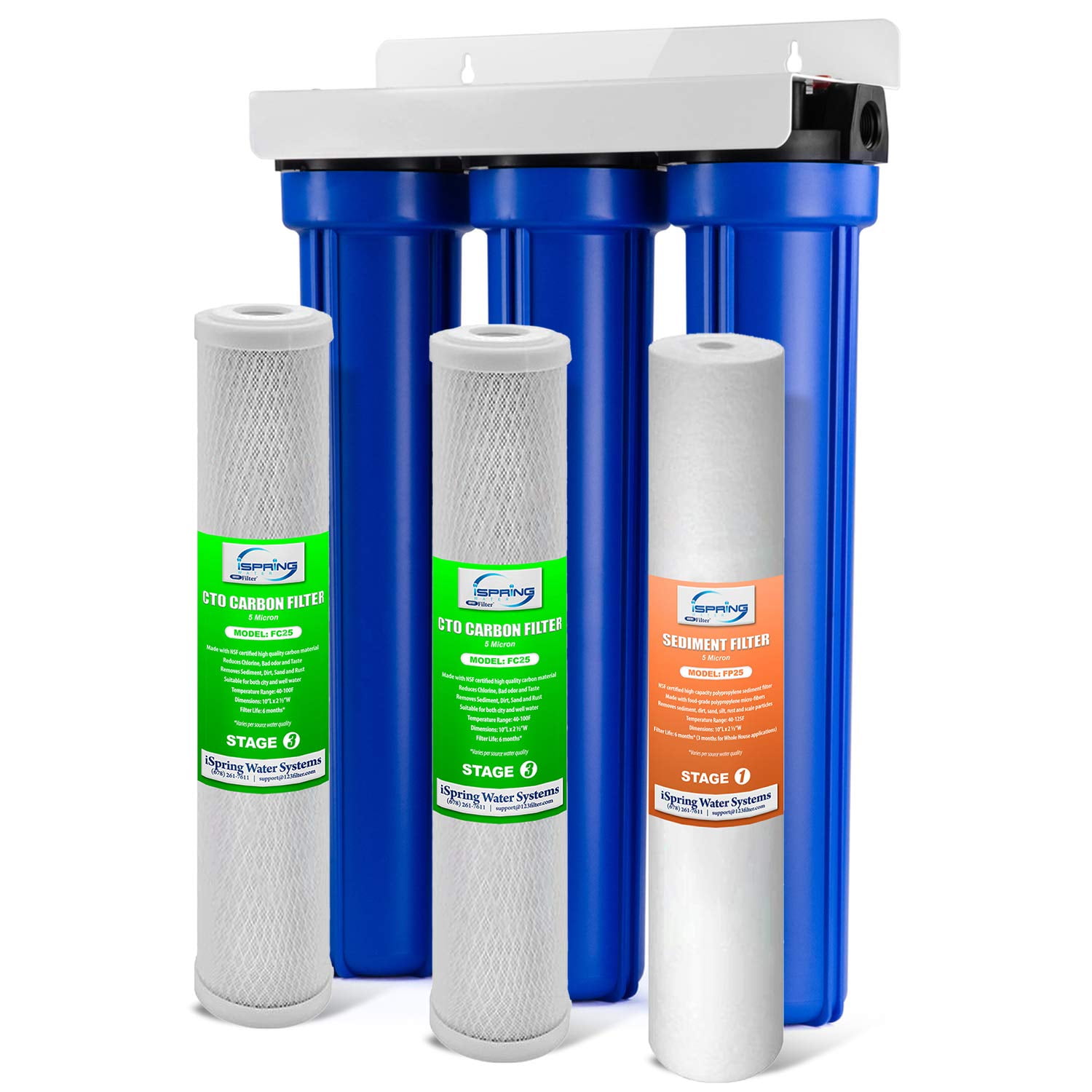Table Of Content

Most of these alternatives are so-called “salt-free softeners” and are offered by big names, such as Aquasana. But a softener that doesn’t use salt isn’t a softener at all because it doesn’t remove calcium and magnesium. Instead, it transforms these minerals so they don’t stick to your pipes, appliances, fixtures, etc. This does eliminate scale buildup, but it does not affect the other annoyances of hard water, such as poorly lathering soap, streaks and stains on your dishes and glasses, and that dry, sandpaper feeling on your skin. It does this using a four-stage filtration process that allows for more-effective contaminant removal than traditional two- or three-stage filters. The first stage includes a sponge-like material (known as a flex-bed) that distributes water over the entire filter media to increase contact time with all filters and improve filtration.
Best Value: iSpring 3-Stage Whole House Water Filtration
Salt is used in all water softeners to regenerate the media, which involves flushing it with salt water to maintain the proper chemical composition for ion exchange to happen. The more often a softener regenerates, the more salt it uses and the more water it wastes. The biggest downside of the CF1 is that it doesn’t treat hard water or filter microbes or fluoride. It’s also not suitable for well water; wells are rarely contaminated with what’s found in city water, and vice versa. That’s why the biggest selling point for me on the SpringWell CF1 was the lifetime warranty that SpringWell offers on all of its products.
The Best Water Softener Salts of 2024
If you have super fine sediment, the 152-micron filter will not be enough. If after you install it, you notice the WS1 is flushing itself more than once a day or you can see sediment in your water, you may want to invest in a second pre-filter with a 5-micron rating. Another drawback of the WS1 is that the sediment filter could be inadequate for some wells. You can tell if you have sulfur in your well by smelling the water, but there’s no way to know if these other contaminants are in there without sending a sample to the lab. If you want a well water filter that is going to age well and last as long as you own your home — and maybe longer — then get the SpringWell WS1.
Why Choose Culligan Whole House Water Filters
How to filter PFAS out of your tap water - WHYY
How to filter PFAS out of your tap water.
Posted: Tue, 08 Aug 2023 07:00:00 GMT [source]
Stage four is a 5-micron sediment filter that will remove any dirt, dust, clay, sand, etc. from your water before it heads to your tap. It does this by using a granular activated carbon filter and sediment filter, which effectively block any particles from making their way into your drinking water. Whole-house water filtration systems use a variety of filtration methods to target specific contaminants in your water, and each method represents one stage of filtration. Basic systems use one stage (usually sediment or carbon), and advanced systems can use seven or more stages.

Best Water Filter Faucet
We concluded from our research and testing that the CF Whole House Water Filter System is the most capable and durable option compared to other systems on the market. However, Pentair has a detailed step-by-step installation guide for this system. If you're experiencing any problems, you can give them a call or get a plumber.
Pentair Pelican Whole House Water Filter System
The downside of this filter is that it does have larger holes that will allow finer sediment particles to get through. Some of this sediment will get caught in the greensand filter bed, preventing it from getting into your water but potentially clogging up the greensand filter and decreasing its effectiveness. No other water filter company out there even comes close to this kind of commitment to its customers. Pro+Aqua and RKIN only offer 10-year warranties, and Aquasana only offers one year. This suggests they either don’t think their products can last that long or they don’t want to deal with helping you should an issue arise.
Remember I said whole-house filtration requires matching a filter with your water? The CF1 does extremely well at removing a number of contaminants, but it doesn’t do so well at others. In addition to removing chlorine from water, it also reduces mercury, chloramines, herbicides, pesticides, and more.

RKIN CBS 5 Micron Sediment Whole House Filter
We test performance factors like how quickly it filters a cup of water and measure how much water the tap water reservoir can hold. Before choosing a whole house water filtration system, you'll need to determine which contaminants are in your water that you want to address. We offer different whole home systems specifically tailored to your home's water issues, whether it’s municipal water treated with chlorine/chloramines, or untreated well water. If you notice only one of the previous facts, you should use a whole house water filtration system. You can go for a point of use solution like an under sink water filter, faucet water filter or a shower filter, too.
Nicole Papantoniou contributed insight on the ease of use of pitchers and bottles. Birnur Aral, Ph.D. helped evaluate the contamination-removal claims behind each of our picks. Dan DiClerico and Rachel Rothman provided expertise on installed filters. We review how long each filter lasts as well as the yearly cost to replace filters when changing filters on the manufacturer's recommended schedule.
Each system will have specific maintenance needs, but generally, it will require changing the filter or UV light at regular intervals. KDF, or kinetic degradation fluxion, uses high-purity zinc and copper media to remove a range of contaminants. Neutralize acidic water to prevent corrosion and reduce iron to get rid of rust stains. Upgrade your water by reducing sulfur and iron while unlocking smart features.
Water filtration systems vary widely in their maintenance needs, and the manufacturer can supply information regarding what your particular system will require. The Rhino® 600,000 gallon model has many of the same features as the well water model, but it comes at a fraction of the price. This SpringWell model has a lot of upsides because it has a one million gallon capacity, so you’ll never run out of clean, filtered water. SpringWell uses a four-stage filtering system, which is an extra stage more than most others on the market. SpringWell also has the distinction of having Bluetooth connectivity, making it easy to operate from your phone. Pair your unit with other treatment system installations since they only neutralize living organisms (like bacteria).
Weighing in at a mere 6 pounds when filled, this small but mighty glass water filter pitcher was lightweight and easy to hold and pour during our tests. Just note that you'll need to refill it more often since it only holds 2.5 cups of tap water. Its filter contains a proprietary blend of KDF-55 and calcium sulfate, which the brand claimed is better than typical carbon-based filters at capturing contaminants from hot, high-pressure shower water. After nearly a year of use, Saguin noticed "less scale buildup near the drain of the tub," adding that the "water feels softer without any sacrifice in pressure."
With a whole house water filtration system, you can also avoid the costs of bottled water, which are thousands of times more than tap water. For example, in Minnesota, tap water costs $0.0058 per gallon, while the average wholesale price of domestic bottled water is approximately $1.18 per gallon. The best way to choose a whole-house water filter is to test your water to find out exactly what’s in it. Guides such as this one can steer you to the right product once you know which type of filter you need. Hard water, or high levels of calcium and magnesium, affects both wells and city water supplies and causes all sorts of headaches. Hard water is responsible for scale buildup on your plumbing fixtures, skin and hair irritation, and poorly lathering soap that makes cleaning difficult.
Check out my reviews below for hard water and well water and see the additional options section for top choices for removing other contaminants. These cartridge systems, such as those offered by Pro Aqua and GE, are touted for being inexpensive and effective whole-house filtration solutions. It’s true they are effective, but only if you remember to change filters every six months. These filter replacements are more expensive than the media used in the CF1, so after just a few years, a cartridge system is actually more expensive than the CF1. Over the course of a decade, the CF1 is considerably less expensive to own.
The maintenance requirements for a home water filtration system will depend on its design and features. Generally speaking, most systems require regular filter replacements every three to six months to maintain optimal performance levels. Other maintenance tasks may include cleaning hoses or faucets, checking for leakage or clogs in pipes or fittings, and keeping valves adjusted, tightened, or lubricated as necessary. To test water filters, we take into account their capacity, how easy they are to set up and, if applicable, how easy they are to pour from. We also read each instruction manual for clarity and look at whether pitcher models are dishwasher safe.
With its easy DIY installation and superior filtration capacity, you can rest easy knowing that your loved ones can access safe and healthy drinking water, making it an invaluable investment for your home. When the water exits the carbon filter, it passes through a copper-zinc and mineral filter. This filter is also very important to the filtering process because it removes most of the contaminants remaining in the water at this point.












